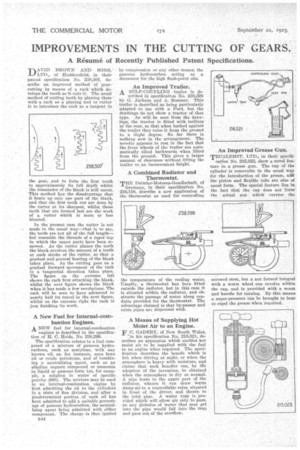IMPROVEMENTS IN THE CUTTING OF GEARS.
Page 28

If you've noticed an error in this article please click here to report it so we can fix it.
A Résumé of Recently Published Patent Specifications.
DAVID BROWN AND SONS,' LTD., of Huddersfield, in their patent specification No. 238,307, describe an improved method of gear. cutting by means of a rack'which develops the tooth as it cuts it. The Usual method of cutting teeth by planing them with a rack as a planing tool or cutter is to introduce the rack as a tangent to
the gear, and to form the first tooth to approximately its full depth whilst the remainder of the blank is still uncut. This method has the disadvantage that it heats up only one part of the blank, and that the first teeth cut are done by the cutter at its sharpest, whilst those teeth that are formed last are the work of a cutter which is more or less blunted.
In the present case the cutter is not made in the usual way—that is to say, the teeth are not all of the full length— but resemble the threads of a taper tap in which the upper parts have been removed. As the cutter planes the teeth the blank revolves the amount of a tooth at each stroke of the cutter, so that a gradual and general heating of the blank takes place. As the cutting goes on a gradual forward movement of the rack in a tangential direction takes place. The figure on the extreme left shows the rack first attacking the blank, whilst the next figure shows the blank when it has made a few revolutions. The rack will he seen to have advanced to nearly half its travel in the next figure, whilst on the extreme right the rack is just finishing its work.
• A New Fuel for Internal-combustion Engines. A. NEW fuel for internal-combustion engines is described in the specification of H. C. Heide, No. 238,299.
The specification relates to a fuel composed of a mixture of gaseous hydrocarbons, such as acetylene, with any known oil, as, for instance, soya bean oil or crude petroleum, and of combining a neutralizing agent, such as an alkaline organic compound or ammonia in liquid or gaseous form (as, for example, a solution in water of specific. gravity .880). The mixture may be used in an internal-combustion engine by • first admitting the oil to the cylinders in a state of fine division, and after a predetermined portion of such oil has been admitted to add a suitable percentage of gaseous hydrocarbon, the neutralizing agent being admitted with either component. The charge is then ignited B44 by compression or any other means, the gaseous hydrocarbon acting as a detonator for the high flash-point oils,
An Improved Trailer. A SELF-COUPLING trailer is de scribed in specification No. 238,398 by G. Jackson and A. Sommer. This trailer is described as being particularly adapted to use with a Ford, but the drawings do not show a tractor of that type. As will be seen from the drawings, the tractor is fitted with inclines at the rear, so that when backed against the trailer they raise it from the ground to a slight degree. So far there is nothing new in the arrangement. The novelty Appears to rest in the fact that the front wheels of the trailer are automatically tilted backwards when lifted from the ground. This gives a larger amount of clearance without lifting the trailer to an inconvenient height.
A Combined Radiator and Thermostat.
THE Daimler-Motoren-Gesellschaft, of Germany, in their specification No. 216,158, describe a new application of the thermostat as used for controlling
the temperature of the cooling water. -Usually, a thermostat has been fitted outside the radiator, but in this case it is situated within the radiator, and obstructs the passage of water along conduits provided for the thermostat. The advantage claimed is that by-passes and extra pipes arc dispensed with.
A Means of Supplying Hot Moist Air to an Engine.
F.° GADSBY, of New South Wales,
'in his specification No. 216,521, describes an apparatus which enables hot moist air to be supplied with the fuel to an engine when required. The specification deseribes the benefit which is felt when driving at night, or when the atmosphere is heavy with moisture, and claims that such benefits can, by die " adoption of the invention, be obtained when the atmosphere is dry or normal. A pipe leads to the upper part of the radiator, whence it can draw warm damp air to a controllable valve situated in front of the driver, and thence to the inlet pipe. A water trap is provided which will allow air only to pass, as any globules of water that may get into the pipe would fall into the trap and pass out of the overflow.
An Improved Grease Gun.
TECALEMIT, LTD., in their specifi cation No. 215,023, show a novel feature in a grease gun. The cap of the cylinder is removable in the usual way for the introduction of the grease, and the piston and flexible tube are also of usual form. The special feature lies in the fact that the cap does not form the actual nut which carries the screwed stem, but a nut formed integral with a worm wheel can revolve within the cap, and is provided with a worm and handle for turning. By this means a super-pressure can be brought to bear to expel the grease when required.




























